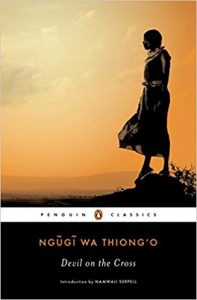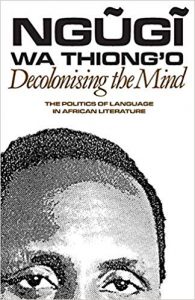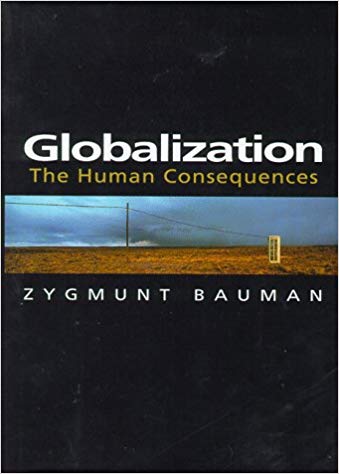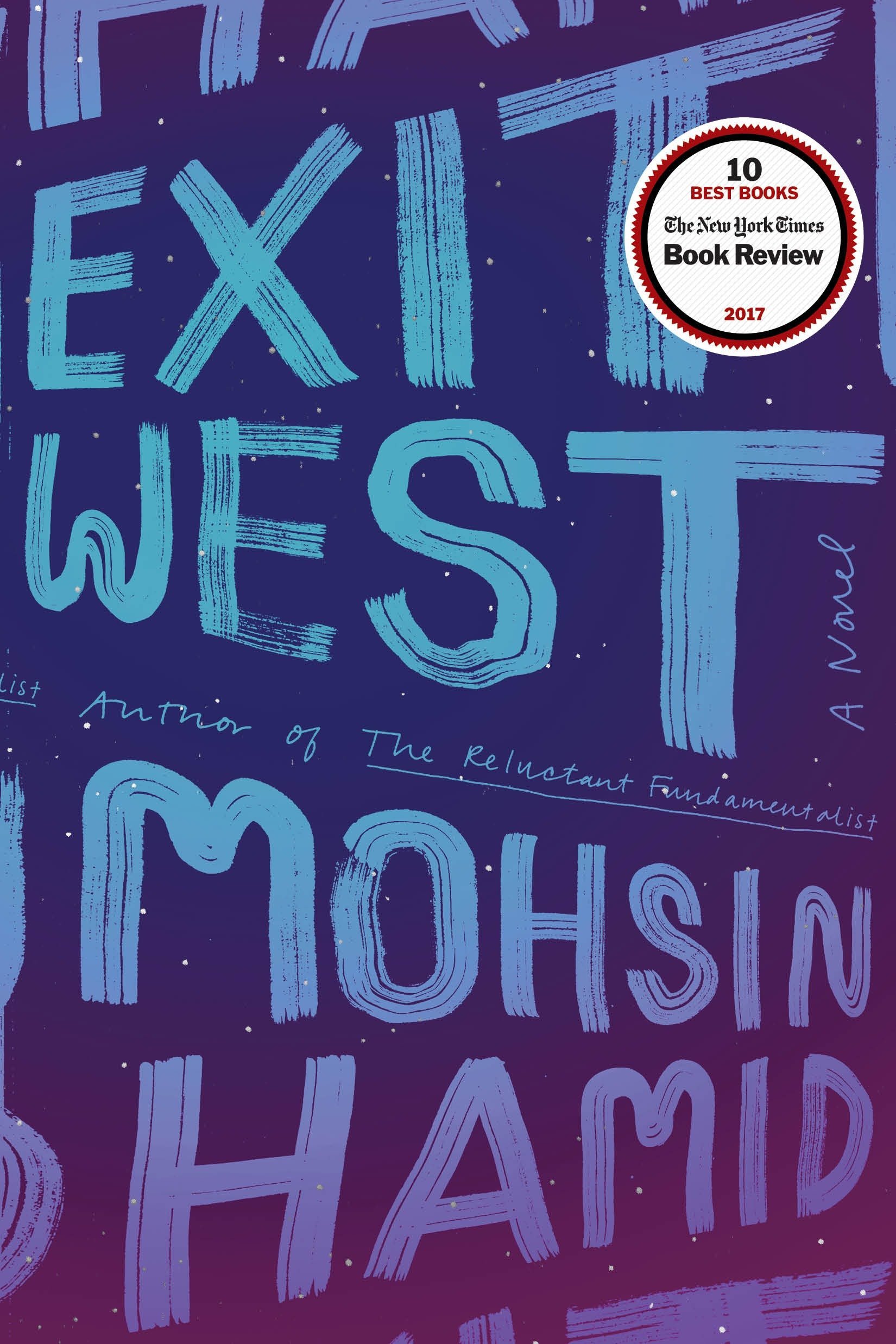Introduction
Devil on the Cross (1980) is one of the finest critiques of national elite of Kenya and their (former) colonial  masters, the International financiers and bankers who still pull the strings in Ngugi’s imagined Kenya. Devil on the Cross was also the first novel by Ngugi that he initially wrote in Gikuyu, as an attempt to create and publish Kenyan literature in one of the major Kenyan languages. Those who are familiar with Ngugi’s work must be aware that for Ngugi, writing in native languages and creating a national literature is crucial to the project of real freedom and Independence form the colonial heritage and influences, and this is the main subject of his book Decolonizing the Mind (Here is one chapter from the book).
masters, the International financiers and bankers who still pull the strings in Ngugi’s imagined Kenya. Devil on the Cross was also the first novel by Ngugi that he initially wrote in Gikuyu, as an attempt to create and publish Kenyan literature in one of the major Kenyan languages. Those who are familiar with Ngugi’s work must be aware that for Ngugi, writing in native languages and creating a national literature is crucial to the project of real freedom and Independence form the colonial heritage and influences, and this is the main subject of his book Decolonizing the Mind (Here is one chapter from the book).
According to some sources:
The novel was written secretly in prison on the only available material — lavatory paper. It was discovered when almost complete but unexpectedly returned to him on his release. Such was the demand for the original Gikuyu edition that it reprinted on publication. (Source: https://ngugiwathiongo.com/devil-on-the-cross/)
Ngugi wrote the novel while in prison, he was imprisoned without trial for producing a popular play, and the novel was eventually published by a local publisher. Thus, the novel became an immediate success and not only did people read the novel but they also read and narrated it to each other over campfires, on the farms in a way transforming a published narrative to an oral story.
What Makes Devil on the Cross Special?
If you like postcolonial African writings, you are in for a treat. This novel is special in many ways
- Obviously, the most important aspect of the novel is that it was originally written in Gikuyu and then translated into English by the author. So, one could assume that the intended audience of the novel IS the natives of Kenya and this focus on a native audience makes the novel special, as it is not written to please, appease, or appeal to the tastes of a purely Western audience.
- It deals with the postcolonial national aspirations and the impact of vestigial colonial legacies on the postcolonial nation-states. Especially how, even after the colonizers leave, the postcolonies still remain dependent upon the international economic order that is still controlled by the West. Furthermore, the colonizers also leave, what Chinweizu calls the “Ariels,” a native elite whose sympathies are more with the colonizers and international forces than with the natives of the postcolonial nation-state. (Read Chinweizu’s views Here)
- It highlights the role of national elites in oppressing their own people in league with their international masters/ collaborators.
- It provides an interesting critique of the neocolonialism by exposing its exploitative practices.
- And, most importantly, it provides a Marxist narrative of self-actualization for Wariinga, the lead female character, through politics and lateral solidarity
 rather than through a romantic form of self-reliance.
rather than through a romantic form of self-reliance.
While you can find the plot summaries and character lists elsewhere, here I will primarily focus on certain conceptual issues that you might want to keep in mind while reading the book.
Significance of the Title: Devil on the Cross
What are we to understand by the title: Devil on the Cross? The crucifixion of the Devil is offered to the readers in the form of Wariinga’s recurring dream:
She saw first the darkness, carved open at one side to reveal a Cross, which hung in the air. Then she saw a crowd of people dressed in rags walking in the light, propelling the Devil towards the Cross. The Devil was clad in a silk suit, and he carried a walking stick shaped like a folded umbrella. On his head there were seven horns, seven trumpets for sounding infernal hymns of praise and glory. The Devil had two mouths, one on his forehead and the other at the back of his head. . . . His skin was red, like that of a pig. (13)
Wariinga’s dream continues, as the people pronounce the Devil’s ill-deeds before crucifying him:
You commit murder, then you don your robes of pity and you go to wipe the tears from the faces of orphans and widows. You steal food from people’s stores at midnight, then at dawn you visit the victims wearing your robes of charity and you offer them a calabash filled with the grain that you have stolen. (13)
But then three days after his crucifixion, the Devil is rescued by a certain specific group:
After three days, there came others dressed in suits and ties, who, keeping close to the wall of darkness, lifted the Devil down from the Cross. And they knelt before him and they prayed to Him in loud voices, beseeching him to give them a portion of his robes of cunning. (13-14)
Obviously, this is a retelling of the Crucifixion of Christ. In this case, however, the devil is not being persecuted by the powerful but is being indicted, charged and punished by the people. And similar to the Christ’s story, the Devil is resurrected but by his disciples who want to emulate all his qualities. In my reading, the Devil is a personification of international/ colonial capital and the disciples are the native elite who, even after the “Devil” has left still rely on the exploitative practices introduced and mastered by the former colonizers. So, one could read the title in itself as a reversal of the traditional associations with the cross and thus read the novel as a journey into the functioning of the “Devil” of capital and the possibilities of resistance against it, especially within the framework of postcolonial nation-state and its workers, peasants, and the poor in opposition to the native elites, the disciples of the Devil!
Importance of Narrative Framing: Gicaandi Player
The story is told from the narrative point of view of Gicaandi Player, who, in the words of James Ogude, is the “Village Prophet . . . in the traditional Agikuyu community,” 1 but this reliance on a traditional storyteller also provides Ngugi the kind of creative cover to seriously critique the postcolonial nation-state itself. This framing is necessary both to ensure the native audiences that the critique of their nation is not meant to deride them for their “backwardness” and to ensure that a work about Kenya is not read by the international readers as an insider’s authentication of the racialized European myths about Africa. So, the Gicaandi player decides to tell the story of Wariinga after her mother beseeches him to tell her story. The figure of the Gicaandi player, thus, offers his reasons for telling the story as follows:
How can we cover up pits in our courtyard with leaves or grass, saying to ourselves that because our eyes cannot see the holes, our children can prance around the yard as they like? Happy is the man who is able to discern the pitfalls in his path, for he can avoid them. (7)
Thus, the figure of the Gicaandi player creates space for Ngugi to tell the story of national ills, caused by a native elite and their International masters, in a way that the critique itself does not become controversial and becomes a sort of corrective for the natives of Kenya. This framing allows Ngugi, in my opinion, to seriously point out as to where and how Kenya has gone wrong in its march to progress after the Independence. It is worthy of note, whoever, that this framing can only defend the writer from the wrath of the people of Kenya, for the elite, who are being indicted in the story, will obviously see this as an attack on their privileged position, but this framing also places the writer in solidarity with the people, who should be the primary concern and main audience of the Gicaandi player as well as a radical postcolonial author.
The Speeches in the Cave: International Organization of Thieves and Robbers
For me, Chapter four of the Devil on the Cross is instructive in several ways. One, it stages, satirically, the naked truth of neoliberalism, its basis in greed, and its alliance with postcolonial national elites in exploiting the people, and two, the scene in the cave also serves as a kind of political awakening for Wariinga, who until then had only seen herself as a victim and who had, until then, not seriously thought about her own place within in the nation and about her own true identity.
The speeches, though highly satirized, display the nature of greed that drives the neoliberal capital and since the speeches are delivered at a meeting called by the “European” masters, the naked truth of global capital, still governed by the North-Atlantic nations, is also revealed, for the participants “boast” of their accomplishments, most involving deceiving their own people, to win the praise and awards offered by the International Organization of Thieves and Robbers. Thus, in this chapter, Ngugi, in my view, stages the vary true dynamics of the neoliberal economic system that offers itself as natural and uncontested.
Wariinga’s Transformation
In the beginning of the novel, Wariinga was someone who “hated her blackness” (11) and straightened her hair with “red-hot iron combs” (11). Thus, while she is unconsciously attempting to shape her physical self into a European version of herself, she also seems to have developed a kind of deep loathing for her own ethnic and cultural identity. This self loathing, according to Ngugi’s other works, is a part of the colonial educational system where the native children do not only learn a foreign langue as a “language of power” but also internalize a certain disdain for their own languages and culture (For more on this, please read Ngugi’s Decolonizing the Mind). Thus, in the beginning of the novel Wariinga does not really know who she is and she has no political or social agency. Deciding to leave Nairobi to go back to her parents, was the first major display of agency that we see from her and it is this decision that puts her on the path to transformation. Surprisingly, it is not a story of a “broken” woman returning to her parents to heal herself: On her way home, Wariinga meets other people: workers, artists, and activists. It is through this encounter with others like her, especially the workers and former revolutionaries, that Wrriinga finally defines her own identity. Understanding this sociopolitical aspect of identity-formation is important to really grasp the the novel, for the novel offers lateral solidarity of workers as the ultimate mode of resistance against oppression. Its is through her alliances and friendships with her new friends and acquaintances that Wariinga finally becomes a successful mechanic and an engineer. Thus, by the time we reach the ending, we already know that it took a whole community of like-minded comrades, a certain degree of understanding of local and global politics to transform Wariinga from an object of oppression to an “angel” of destruction.
In the final scene, after having shot her oppressor, Wariinga is transformed into a goddess-like figure and the novel ends as follows:
Wariinga walked on, without once looking back. But she knew with all her heart that the hardest struggle of her life’s journey lay ahead . . .” (254).
One could call this an open ending, but as a reader who has seen Wariinga transform over the course of the story, I have no doubt imagining that she will be all right and that she will always have friends and comrades to rely on! And it is this ending and this reliance on lateral, collective support structures in developing a self that I find the most interesting part of the novel.
Conclusion
These are just some basic notes about the novel and are in no way exhaustive. If you find something else that could be interesting and of some use to other readers of the novel, please feel free to add your ideas to the comments section below.
Notes:
- Ogude, James. Ngugi’s Novels And African History: Narrating the Nation. (Pluto Press, 1999): 95. ↩





Very good analysis and it helps in understanding Ngugi’s uniqueness as a writer.
This is a great help to both me and all my partners
Thank you!
This was totally helpful. Thank you
[…] Reading Notes for “Devil on the Cross” by Ngugi wa Thiong’o […]